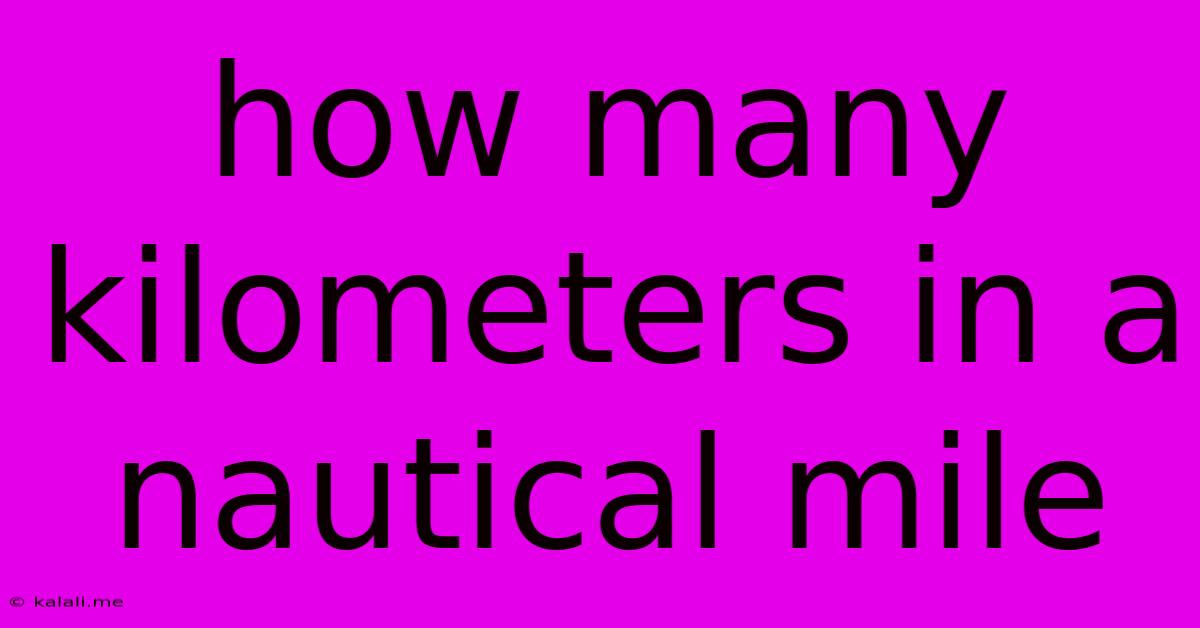How Many Kilometers In A Nautical Mile
Kalali
Jun 16, 2025 · 3 min read

Table of Contents
How Many Kilometers in a Nautical Mile? A Comprehensive Guide
Meta Description: Ever wondered how many kilometers are in a nautical mile? This guide provides a clear explanation of the conversion, the history of nautical miles, and their continued use in navigation and maritime applications.
Many people find themselves needing to convert nautical miles to kilometers, especially those involved in shipping, aviation, or geography. Understanding the difference between these units of measurement is crucial for accurate calculations and comprehension of distances, particularly across large bodies of water. So, how many kilometers are in a nautical mile? The short answer is approximately 1.852 kilometers. But let's delve deeper into the specifics.
The Origin and Definition of a Nautical Mile
Unlike the standard kilometer (or mile), which is a land-based unit of measurement, the nautical mile is defined by the Earth's circumference. Historically, a nautical mile was defined as one minute of latitude. Since the Earth is not a perfect sphere, this definition varied slightly depending on the latitude.
To address this inconsistency, the International Hydrographic Organization (IHO) standardized the nautical mile to precisely 1852 meters, or 1.852 kilometers. This internationally recognized standard ensures consistency across all maritime and aviation applications.
Why Nautical Miles are Used in Navigation
Nautical miles remain the preferred unit of measurement in navigation for several key reasons:
- Latitude/Longitude System: The nautical mile's historical connection to latitude makes it inherently compatible with the latitude/longitude coordinate system used for global positioning.
- Ease of Calculation: The relationship between nautical miles and minutes of latitude simplifies distance calculations, particularly when dealing with great-circle distances (the shortest distance between two points on a sphere).
- Maritime and Aviation Standards: Its widespread use in maritime charts, navigational instruments, and aviation ensures universal understanding and reduces the risk of errors.
- Historical Significance: The long-standing usage in seafaring and aviation has cemented its place as the standard unit for navigation.
Converting Nautical Miles to Kilometers and Vice Versa
The conversion is straightforward:
- Nautical Miles to Kilometers: Multiply the number of nautical miles by 1.852. For example, 10 nautical miles is equal to 10 * 1.852 = 18.52 kilometers.
- Kilometers to Nautical Miles: Divide the number of kilometers by 1.852. For example, 20 kilometers is equal to 20 / 1.852 = approximately 10.8 nautical miles.
Beyond the Basics: Understanding Knots
Closely related to the nautical mile is the knot, a unit of speed. One knot is defined as one nautical mile per hour. Understanding this relationship is crucial for accurate speed calculations in maritime and aviation contexts. For instance, a ship traveling at 10 knots is covering 10 nautical miles every hour.
Conclusion
The nautical mile, while seemingly archaic to some, remains a vital unit of measurement for navigation, especially at sea and in the air. Its precise definition and established usage ensure accuracy and consistency in critical applications. Understanding the simple conversion between nautical miles and kilometers is essential for anyone working with global positioning, maritime charts, or aviation calculations. Remember that approximately 1.852 kilometers equals one nautical mile.
Latest Posts
Latest Posts
-
The Word Atom Comes From A Greek Word That Means
Jun 16, 2025
-
Henry Ford Is Noted For His Contributions To
Jun 16, 2025
-
An Inner Transition Metal With Seven 4f Electrons
Jun 16, 2025
-
Least Common Multiple Of 4 6 9
Jun 16, 2025
-
Are Secondary Storage Devices That Use Laser Technology
Jun 16, 2025
Related Post
Thank you for visiting our website which covers about How Many Kilometers In A Nautical Mile . We hope the information provided has been useful to you. Feel free to contact us if you have any questions or need further assistance. See you next time and don't miss to bookmark.